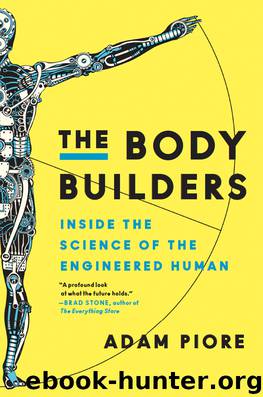The Body Builders by Adam Piore

Author:Adam Piore
Language: eng
Format: epub
Publisher: HarperCollins
Published: 2017-01-24T16:00:00+00:00
Cohn was aware of all these efforts. But he wanted to go further. Cohn wasn’t interested in building a device to enhance performance in the field—he wanted a device or a technique he could use to actually train and hone the human mind, so you wouldn’t need a computer to detect a threat in the field.
Cohn also wasn’t satisfied with the P300 response, which didn’t tell you much about what was actually happening and where it was happening in the brain.
Cohn realized he would first have to somehow demonstrate he could find a much more localized and specific brain signal. In order to prove it was “intuition,” he would then have to prove it was present when his test subjects knew something without knowing they knew it.
The idea, however, was not as difficult as it might sound, because there is, in fact, a rich body of scientific literature that provides some powerful clues as to how to test for this and where to look. The literature comes from the study of individuals who are in many ways on the other end of the spectrum of functionality from Klein’s heroic firefighters—amnesiacs.
If you want to understand the capacity of the brain to retain information outside conscious awareness, individuals who have lost all ability to form new long-term memories are the perfect patients to study because they can’t consciously know they know anything new. How could they? They can’t remember learning new things. By studying amnesiacs in the twentieth century, scientists discovered something that genuinely surprised them—and which to this day seems counterintuitive: that even without the capacity to remember what we had for lunch yesterday, natural selection has imbued all of us with powerful machinery that ensures we can continue to hone those instinctual gut feelings that might, in a pinch, save our lives. Scientists now have a name for this process: “implicit learning.”
One of the first recorded accounts of implicit learning in an amnesiac was made more than a hundred years ago by the Swiss psychologist Édouard Claparède. In 1911, he reported the case of a forty-seven-year-old amnesiac with a condition related to thiamine deficiency that had eaten away at an area of her brain known as the hippocampus, a curving, seahorse-shaped structure buried far below the outer cortex. This patient still retained memories formed before her illness—she could name all the European capitals, do arithmetic, and carry on a conversation. But she couldn’t recognize the doctors she saw every day, no matter how many times they reintroduced themselves.
Claparède wondered if there were exceptions. So one day he concealed a pin in his palm before shaking the patient’s hand. When the pin pricked her skin, she recoiled in pain. The next day, the patient claimed to have no conscious memory of the previous day. And indeed, when she encountered the doctor she behaved as if she had never seen him before. Yet when Claparède extended his hand to introduce himself again, the patient refused to shake it. She could not explain why she looked askance at his outstretched palm.
Download
This site does not store any files on its server. We only index and link to content provided by other sites. Please contact the content providers to delete copyright contents if any and email us, we'll remove relevant links or contents immediately.
| Biochemistry | Biomedical Engineering |
| Biotechnology |
Whiskies Galore by Ian Buxton(41941)
Introduction to Aircraft Design (Cambridge Aerospace Series) by John P. Fielding(33095)
Small Unmanned Fixed-wing Aircraft Design by Andrew J. Keane Andras Sobester James P. Scanlan & András Sóbester & James P. Scanlan(32767)
Craft Beer for the Homebrewer by Michael Agnew(18200)
Turbulence by E. J. Noyes(7983)
The Complete Stick Figure Physics Tutorials by Allen Sarah(7339)
Kaplan MCAT General Chemistry Review by Kaplan(6903)
The Thirst by Nesbo Jo(6882)
Bad Blood by John Carreyrou(6584)
Modelling of Convective Heat and Mass Transfer in Rotating Flows by Igor V. Shevchuk(6408)
Learning SQL by Alan Beaulieu(6239)
Weapons of Math Destruction by Cathy O'Neil(6220)
Man-made Catastrophes and Risk Information Concealment by Dmitry Chernov & Didier Sornette(5958)
Digital Minimalism by Cal Newport;(5707)
Life 3.0: Being Human in the Age of Artificial Intelligence by Tegmark Max(5519)
iGen by Jean M. Twenge(5387)
Secrets of Antigravity Propulsion: Tesla, UFOs, and Classified Aerospace Technology by Ph.D. Paul A. Laviolette(5336)
Design of Trajectory Optimization Approach for Space Maneuver Vehicle Skip Entry Problems by Runqi Chai & Al Savvaris & Antonios Tsourdos & Senchun Chai(5040)
Pale Blue Dot by Carl Sagan(4960)
